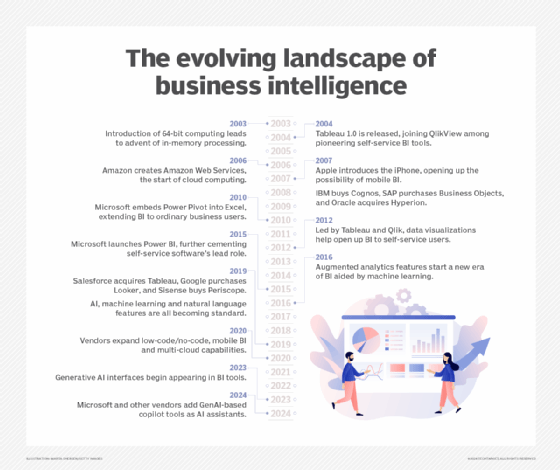
Fotolia
Comparing business intelligence vs. business analytics
Business intelligence with descriptive analytics gives a better understanding of your current operations, while business analytics aims to inform future decisions.
Business analytics and business intelligence are similar enough to cloud the understanding of experts in the industry, but understanding their applications and best practices is important to getting the best insights from your data.
Organizations gather tremendous amounts of data and the ways they manage this data and analyze it can define their success. Mastering data means understanding the differences between business analytics (BA) vs. business intelligence (BI), how they interact and their best practices.
Business intelligence and its applications
Business intelligence is a technology-driven process for analyzing data and presenting actionable information to your organization. Business intelligence is an understanding of your organization's present situation, what events led to you this situation and where you are in your field.
"Business intelligence is meant to summarize predefined historic and current data points through different data processes," said Boaz Jan, the director of engineering for BigBrain at Monday.com, a project management tool vendor. "BI is mostly being used as a way to generate a detailed overview either on business (revenue in each country) or product metrics (new signups by acquisition source)."
BI relies on data and descriptive analytics to paint a picture of your present situation. When marketing analysts are analyzing the results of your latest marketing campaign, they are conducting a BI process. BI tells you what made this campaign effective, where it fell short and the reasons behind both by taking a look back.
Descriptive analytics takes data and provides managers and users with insights into historical performance. Reports with descriptive analytics are run often to answer questions about lackluster performance or to explain success.
The term business intelligence comes to life in the form of every dashboard, custom data report and data query process that runs over company databases, according to Shalev Barel, group product manager at Monday.com.
BI becomes a necessary part of an organization when they want to better understand what they have done right to this point. This is where business intelligence and business analytics differ.

Business analytics and its role in the enterprise
Both BI and business analytics rely on the same data points in order to function correctly. The insights you are looking for are what tend to differentiate the two. Descriptive analytics lies beneath the surface of BI, but predictive analytics powers BA.
"BA puts a higher focus on trying to generate actionable insights for decision-makers," Jan said. "Instead of just summarizing historical data points as the BI process is doing, BA also tries to predict trends."
Business analytics takes BI and attempts to provide insight into potential future successes and failures. The predictive analytics are supposed to highlight correlations between different customer segments and guide future business planning. Organizations planning their future turn to predictive analytics rather than descriptive analytics.
The predictive atmosphere with business analytics shows itself in the tools used. Data mining, statistical analysis and predictive modeling are heavily relied upon in business analytics, and this means having a strong data science team.
"The tools being used in BI are mainly simple descriptive statistics -- e.g., moving average of e-commerce conversion rate -- where BA can take advantage of machine learning and other sophisticated statistical models," Barel said.
The hierarchy of BI and BA
Both business intelligence and business analytics rely on the same data and both analyze data sets to help provide insights for an organization, but companies traditionally begin with business intelligence before employing business analytics.
"BA is highly relying on BI as a starting point. BI can point and direct the efforts of where you should take the time to go a 'level deeper' and allocate the BA resources to unlock interesting predictions and derive meaningful insights," Barel said.
This traditional approach was commitment-heavy and resource-dependent, not to mention time-consuming.
"The traditional approach has been for organizations to build business analytics from heavy investments in business intelligence," said Ryan Wong, CEO and co-founder of Visier, a workforce analytics and planning vendor. "They hired armies of analysts, data management staff, report writers, data scientists, developers and testers in order to build BA."
Companies can save time and money by avoiding having to build out of BI infrastructure now, according to Wong. Technology has gotten to the point where organizations can go straight into business analytics if they need to.
Tools of the trade
The overlap for business intelligence vs. business analytics continues for the tools that they both use. The presentation of data for both can include tools such as Tableau, AWS QuickSight, Microsoft Power BI and Qlik.
Craig Kelly, vice president of analytics at Syntax, an ERP services provider, said the differentiation of the two is in the transformation and storage tools rather than the tools that assist with the presentation of data.
"For BI, the data is typically transformed into optimized schema structures and traditionally stored in a data warehouse for KPI reporting," Kelly said. "Business analytics -- conversely -- will store its data in data lakes, where the central storage of data from multiple sources can make it easier for analysts and data scientists to work with everything they need."
Data lakes provide organizations with the flexibility of leaving metadata undefined and makes it easier for these analysts and scientists to mine the data or make it accessible for machine learning.
"Azure and AWS both have a myriad of tools that provide the necessary infrastructure to store, transform and analyze data in a data lake," Kelly said.







